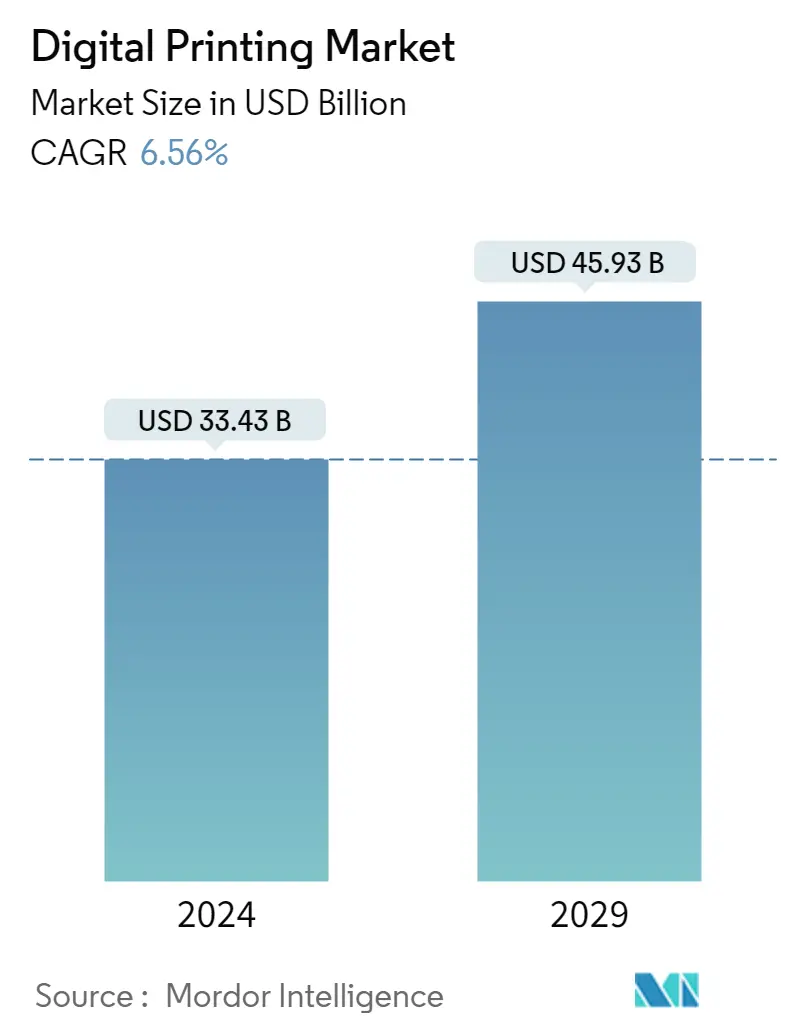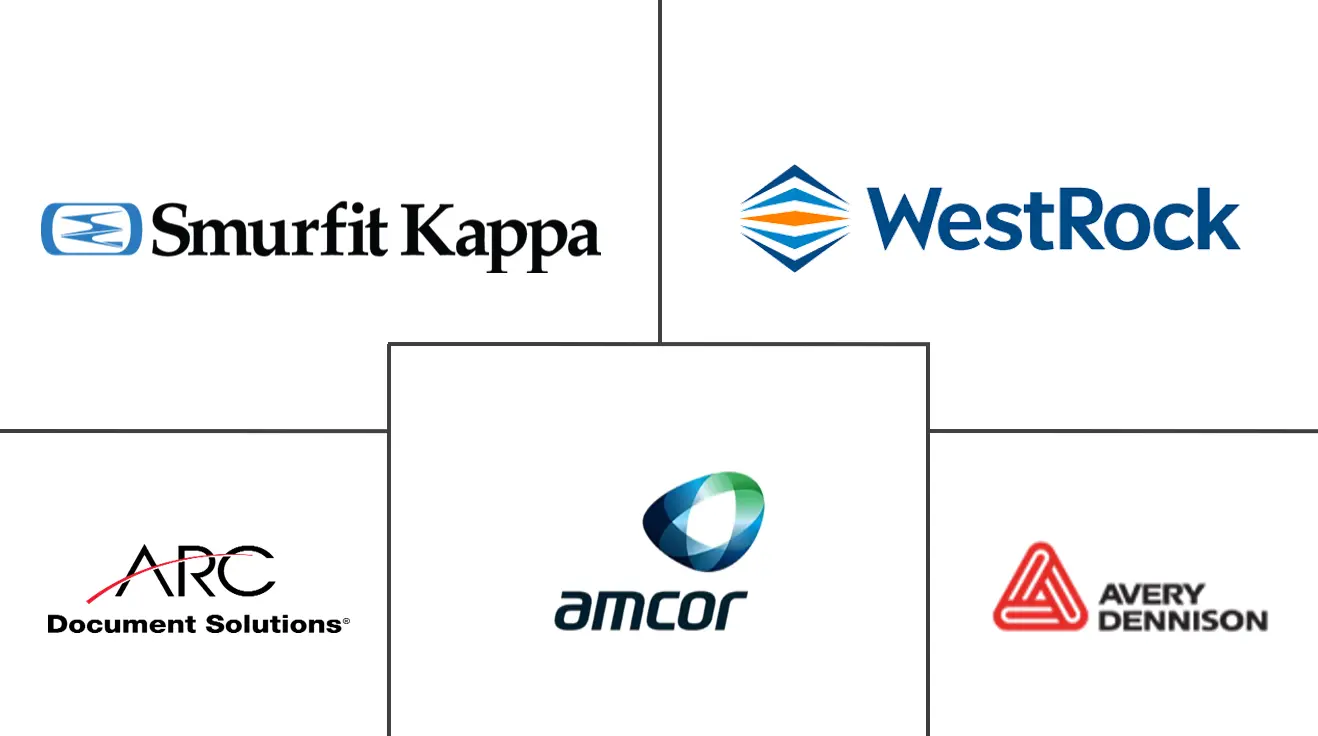Market Size of Digital Printing Industry

| Study Period | 2019 - 2029 |
| Market Size (2024) | USD 33.43 Billion |
| Market Size (2029) | USD 45.93 Billion |
| CAGR (2024 - 2029) | 6.56 % |
| Fastest Growing Market | Asia Pacific |
| Largest Market | North America |
Major Players
*Disclaimer: Major Players sorted in no particular order |
Digital Printing Market Analysis
The Digital Printing Market size is estimated at USD 33.43 billion in 2024, and is expected to reach USD 45.93 billion by 2029, growing at a CAGR of 6.56% during the forecast period (2024-2029).
Digital printing is one of the fastest-growing segments of the sign industry. Its rise can be seen in the incredible size of what can be produced now. Whatever the message or product, size has become a significant trend in advertising.
- Significant improvements in print manufacturing efficiency, time-efficient production, and enhanced focus on supply chain management, such as better demand forecasting, have reduced the print market's overall waste. Technological advancements favoring digital printing have enabled waste minimization, maintaining high print quality.
- The advanced technology of digital printing includes mild solvents and less-harmful chemicals than the ones used in conventional printing technologies, like solid ink printing and offset printing. Hence, the demand for digital printing solutions is growing in the printed electronics market, increasing the focus on green printing and cost-effective production.
- Commercial printing is witnessing transitional and structural changes as a significant application, as the immediate transition from conventional methods of print to digital is challenging. Since it is still a niche method requiring print of shorter/customized batches, the printing cost is expected to take a toll.
- Various companies have been investing in multiple solutions, expansion activities, partnerships, and collaboration activities, to enhance their market position, to expand their presence across the world. For instance, in April 2022, Canon USA, Inc., a digital imaging solutions company, announced the PRISMAcolor Manager solution. The solution can assist users in evaluating and monitoring print quality using compatible printers. It also shows users how their printed color compares to either one of the accepted commercial industries or a user's internal printing specifications. Being a cloud-based solution, it is easy to deploy and allows users to track and compare results over time.
- The latest advancements, such as AI, machine learning, IoT, data analytics, etc., have personalized offerings to a great extent. The convergence in digital printing enables superiority in print personalization for large-volume orders. However, the cost factor remains a big hurdle. Additionally, high-priced investment restrains the overall market growth of the digital printing industry. These costs included the purchase price, support costs, installation fees (if applicable), maintenance, and the price of ink and other consumables.
Digital Printing Industry Segmentation
Digital printing is a process that involves high-quality, on-demand print. It represents a modern production technology that enables printing from electronic files.
The digital printing market is segmented by printing process (electrophotography, inkjet), application (books, commercial printing, packaging (labels, corrugated packaging, cartons, flexible packaging, rigid plastic packaging, metal packaging)), and geography. The market sizes and forecasts are provided in terms of value (USD million) for all the above segments.
| By Printing Process | |
| Electrophotography | |
| Inkjet |
| By Application | ||||||||
| Books | ||||||||
| Commercial Printing | ||||||||
|
| By Geography | |||||||||||
| |||||||||||
| |||||||||||
| |||||||||||
| |||||||||||
| Middle East and Africa |
Digital Printing Market Size Summary
The digital printing market is experiencing robust growth, driven by advancements in technology and increasing demand for efficient, high-quality printing solutions. This sector is rapidly evolving, with digital printing becoming a significant component of the sign industry due to its ability to produce large-scale prints with precision. The shift from traditional printing methods to digital solutions is facilitated by improvements in manufacturing efficiency and supply chain management, which have significantly reduced waste. The adoption of digital printing is further bolstered by its environmentally friendly attributes, such as the use of mild solvents and less harmful chemicals compared to conventional methods. This trend is particularly evident in the packaging industry, where digital printing technologies are being integrated into various packaging methods to meet specific branding and product demands.
The market landscape is characterized by intense competition, with major players investing in technological innovations and strategic partnerships to enhance their market presence. Companies are increasingly adopting digital presses to improve production capacity and meet the growing demand for personalized and variable data printing. The packaging sector, including corrugated boxes, flexible packaging, and rigid plastic packaging, is a key area of growth, with digital printing offering significant advantages in terms of speed, efficiency, and customization. Despite the high initial investment costs associated with digital printing technologies, the market is poised for substantial growth, supported by ongoing advancements and the increasing adoption of digital solutions across various industries.
Digital Printing Market Size - Table of Contents
-
1. MARKET DYNAMICS
-
1.1 Market Overview
-
1.2 Industry Attractiveness - Porter's Five Forces Analysis
-
1.2.1 Bargaining Power of Suppliers
-
1.2.2 Bargaining Power of Buyers
-
1.2.3 Threat of New Entrants
-
1.2.4 Threat of Substitute Products
-
1.2.5 Intensity of Competitive Rivalry
-
-
1.3 Technology Snapshot
-
1.4 Assessment of the Impact of COVID-19 on the Market
-
-
2. MARKET SEGMENTATION
-
2.1 By Printing Process
-
2.1.1 Electrophotography
-
2.1.2 Inkjet
-
-
2.2 By Application
-
2.2.1 Books
-
2.2.2 Commercial Printing
-
2.2.3 Packaging
-
2.2.3.1 Labels
-
2.2.3.2 Corrugated Packaging
-
2.2.3.3 Cartons
-
2.2.3.4 Flexible Packaging
-
2.2.3.5 Rigid Plastic Packaging
-
2.2.3.6 Metal Packaging
-
-
-
2.3 By Geography
-
2.3.1 North America
-
2.3.1.1 United States
-
2.3.1.2 Canada
-
-
2.3.2 Europe
-
2.3.2.1 United Kingdom
-
2.3.2.2 Germany
-
2.3.2.3 France
-
2.3.2.4 Italy
-
2.3.2.5 Spain
-
2.3.2.6 Netherlands
-
2.3.2.7 Russia
-
2.3.2.8 Poland
-
2.3.2.9 Rest of Europe
-
-
2.3.3 Asia-Pacific
-
2.3.3.1 China
-
2.3.3.2 India
-
2.3.3.3 Japan
-
2.3.3.4 Rest of Asia-Pacific
-
-
2.3.4 Latin America
-
2.3.4.1 Brazil
-
2.3.4.2 Mexico
-
2.3.4.3 Rest of Latin America
-
-
2.3.5 Middle East and Africa
-
-
Digital Printing Market Size FAQs
How big is the Digital Printing Market?
The Digital Printing Market size is expected to reach USD 33.43 billion in 2024 and grow at a CAGR of 6.56% to reach USD 45.93 billion by 2029.
What is the current Digital Printing Market size?
In 2024, the Digital Printing Market size is expected to reach USD 33.43 billion.

